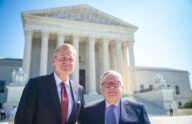Over the top "critical habitat" regulations at risk of extinction
In a recent post, I discussed our Markle case in which PLF sued the U.S. Fish and Wildlife Service for grossly exceeding its authority under the Endangered Species Act. In June of 2012, the Service blatantly ignored the express language of the Act and designated 1500 acres of private land in Louisiana as “critical habitat” for the dusky gopher frog the agency admits is unsuitable as habitat, but hopes may become suitable someday. In other words, the Service declared potential habitat actual habitat essential to the conservation of the species. Although the district court and the Fifth Circuit Court of Appeals “reluctantly” upheld this expansive interpretation of the ESA, 6 judges on the Fifth Circuit expressed the view that the agency decision is both illogical and illegal because nonhabitat can never be “critical habitat.” And, the agency decision would lead to unfettered federal power by allowing the Service to set aside any area of the Country for species protection, without meaningful limits. To protect landowners from this abuse of power, we will petition the case to the U.S. Supreme Court. But there is more to the story.
Emboldened by its current, but likely temporary success, in the Markle case, the Service decided to codify its misinterpretation of the Endangered Species Act be issuing new regulations redefining “critical habitat.” The Act itself defines “critical habitat” as those areas essential to the conservation of a protected species. Since 1984, the Service relied on regulations that are generally consistent with the Act and expressly require “critical habitat” to contain the physical and biological features that will sustain the species. But last year, the Service did an “about-face” and issued the new regulations declaring “critical habitat” can include any area that may be made suitable for habitat. The danger in this approach is that with enough effort any area can be made suitable for habitat, even if it’s currently uninhabitable like the 1500 acres in the Markle case.
In November, 2016, 18 States challenged the new rules in the Southern District of Alabama. As we did in the Markle case, the States argue the new rules are over broad and clearly contradict the Endangered Species Act and the intent of Congress. Congress intended to limit the scope of “critical habitat” to prevent undue hardship on landowners who must bear the cost of species conservation. That is why the Act requires the Service to conduct a balancing test that weighs the economic cost to the landowner of preserving the area against the benefit to the species. In Markle, the agency estimated the landowners could lose up to $34 million in profits under the “critical habitat” designation but provided no evidence that the gopher frog would receive any benefit from the designation. Nevertheless, the Service inexplicably declared the benefit to the species outweighed the cost to the landowners.
As we were preparing our own challenge to these rules, the new Administration was ushered in that would likely take a dim view of such flagrant overreaching. Consequently, on January 17, 2017, a coalition of 14 States sent a letter to the new Administration’s Policy Implementation Team urging the Administration to recall the new rules and reinstate the old rules that are legally supportable. That apparently had some effect, because on February 9 the Service filed a motion with the Alabama District Court to stay the State challenge so the new Administration could be briefed on the case and decide what to do with the rules. The district court granted the stay for 60 days on February 10. While the Administration considers its options, we will continue to prepare our challenge to the rules and move forward with the Markle case in the Supreme Court. If the Administration does not withdraw the new rules, a win in Markle will effectively override the new rules.



